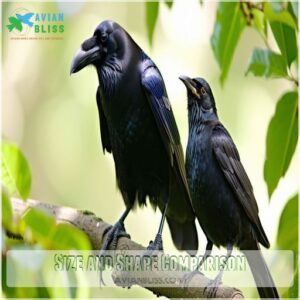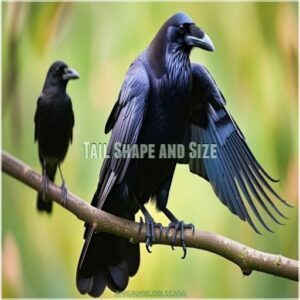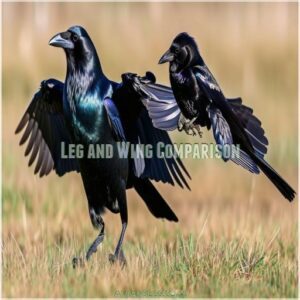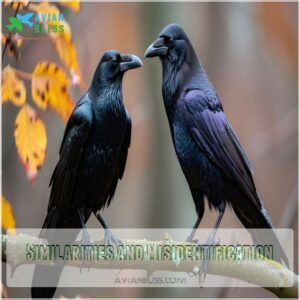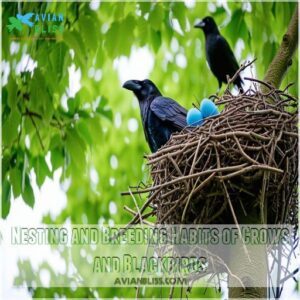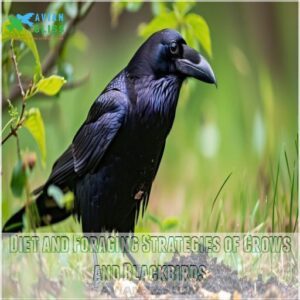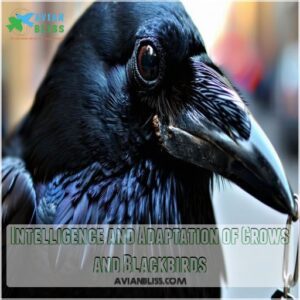This site is supported by our readers. We may earn a commission, at no cost to you, if you purchase through links.
 You’ll spot the difference between a crow vs blackbird from a mile away once you know what to look for.
You’ll spot the difference between a crow vs blackbird from a mile away once you know what to look for.
Crows are the heavyweights, measuring 16-21 inches with robust bodies, while blackbirds are more compact at 9-11 inches.
Listen closely: crows announce themselves with distinctive caws, but blackbirds prefer melodious songs.
You’ll find crows strutting confidently through cities and forests, showing off their problem-solving skills, while blackbirds prefer wetlands and grasslands, feasting on insects and berries.
Their intelligence sets them apart too – crows are nature’s masterminds, capable of using tools and remembering human faces.
Table Of Contents
- Key Takeaways
- Physical Characteristics of Crows and Blackbirds
- Key Differences Between Crows and Blackbirds
- Habitat and Distribution of Crows and Blackbirds
- Behavioral Patterns of Crows and Blackbirds
- Nesting and Breeding Habits of Crows and Blackbirds
- Diet and Foraging Strategies of Crows and Blackbirds
- Intelligence and Adaptation of Crows and Blackbirds
- Frequently Asked Questions (FAQs)
- What is the difference between a crow and a blackbird?
- Are Ravens similar to crows vs blackbirds?
- Do crows and blackbirds have the same plumage?
- What birds do not belong to a crow or a blackbird?
- Do crows and blackbirds have different beaks?
- What does a blackbird Crow sound like?
- Is there a difference between a blackbird and a crow?
- Is the blackbird part of the crow family?
- How do you tell if a bird is a crow?
- What bird is mistaken for a crow?
- Do crows and blackbirds flock together?
- How long do crows and blackbirds live?
- Which bird causes more damage to crops?
- Can crows and blackbirds interbreed?
- Are crows or blackbirds more aggressive to humans?
- Conclusion
Key Takeaways
- You’ll spot crows by their larger size (16-21 inches) and robust build, while blackbirds are notably smaller at 7-11 inches with slender bodies.
- You can identify them by sound – crows make distinctive caw calls, but blackbirds produce melodious, flute-like songs.
- You’ll find crows thriving in cities and forests where they show off their problem-solving skills, while blackbirds prefer wetlands and grasslands for insect foraging.
- You can tell them apart by their beaks – crows have thick, sturdy beaks (2-2.5 inches) for tearing and prying, while blackbirds sport shorter, pointed beaks (0.8-1 inch) for precision feeding.
Physical Characteristics of Crows and Blackbirds
You’ll notice striking differences between crows and blackbirds when you look at their size, plumage, and body features.
While crows measure 16 to 21 inches with thick necks and large beaks,
blackbirds are much smaller at 7 to 11 inches with more slender bodies and shorter, pointed beaks.
Size and Shape Comparison
At first glance, you might mistake a crow for a blackbird, but size makes all the difference.
Crows tower over their smaller cousins, measuring 16-21 inches long and weighing a hefty 400g. You’ll notice their thick necks and sturdy legs, perfect for their ground-foraging lifestyle.
Blackbirds are more modest in size, reaching just 7-11 inches with a lighter build of around 102g.
Plumage and Iridescence
Looking at these birds’ plumage, you’ll notice striking differences in their glossy black feathers.
Crows display a subtle violet iridescence, creating a shimmer that’s visible when sunlight hits just right.
Meanwhile, blackbirds showcase more dramatic color variations – males sport vibrant red-and-yellow wing patches, while females wear muted brown tones.
This iridescence isn’t just for show; it plays a key role in courtship displays and species recognition.
Beak Shape and Size
Beyond their glossy feathers, you’ll spot major differences in beak design between these birds. Here’s how their beaks stack up:
- Crow beaks are thick, sturdy tools (about 2-2.5 inches) perfect for tearing and prying
- Blackbird beaks are shorter and more pointed (about 0.8-1 inch) for precision feeding
- Crows sport slightly curved beaks with a smooth ridge
- Blackbirds have straight, sharp beaks with a defined edge
Tail Shape and Size
The distinctive tail shapes of crows and blackbirds can help you tell them apart at a glance.
Crows with their fan-shaped tail are often associated with products reflecting their crow tail shape characteristics.
You’ll notice crows sport a straight, fan-shaped tail that’s rounded at the edges, while blackbirds have a slightly tapered tail that’s more elongated.
When perched, a crow’s tail appears fuller and broader, measuring about 19-23 centimeters, whereas a blackbird’s more slender tail typically reaches 11-13 centimeters.
Leg and Wing Comparison
You’ll spot distinct differences in how crows and blackbirds move through their environments. Crows swagger confidently on longer, thicker legs with a pronounced walking gait, while blackbirds hop more frequently on their shorter legs.
Crows and other corvids, such as ravens, have specific tail shape characteristics.
Regarding wings, crows boast an impressive wingspan up to 39 inches, allowing for powerful, direct flight. Blackbirds, with their smaller 15-inch wingspan, display more agile, darting flight patterns.
Key Differences Between Crows and Blackbirds
You’ll notice distinct differences between crows and blackbirds when you spot them in your backyard or local park, from their striking size contrast to their unique behaviors.
While both birds share a dark appearance, you can quickly tell them apart by looking at specific features like the crow’s larger size (16-21 inches) compared to the blackbird’s smaller frame (7-11 inches), along with their different tail shapes and distinctive calls.
Distinctive Features of Crows
Identifying a crow’s distinctive features starts with their impressive size – about as big as a house cat!
Looking closely, you’ll spot their broad, slightly curved beak with unique nasal bristles, which is often compared to a blackbird beak in terms of shape and functionality – check out crow vs blackbird beak comparisons for more details.
These intelligent birds showcase hackles (throat feathers) during displays and practice cooperative breeding and winter brooding.
Unlike their smaller cousins, crows have thick necks and longer legs, making them stand out in any crowd.
Distinctive Features of Blackbirds
Looking closely at a blackbird reveals distinct features you won’t find in crows.
Adult males sport glossy black plumage that shimmers in sunlight, while females wear sooty brown feathers with a lighter throat.
Their relatively small beaks and slightly tapered tails set them apart, along with their melodious songs.
During breeding season, males display golden-yellow bills, while females maintain dull yellow-brownish ones.
Similarities and Misidentification
Despite their distinct features, these black-feathered birds share enough similarities to cause confusion, especially in low light or from a distance.
The most common mix-up happens with juvenile crows, which can appear similar in size to adult blackbirds.
Their calls might also overlap when heard from afar, and both species often frequent the same urban spaces, making quick identification tricky without careful observation.
Habitat and Distribution of Crows and Blackbirds
You’ll find crows scattered across the United States and southern Alaska, where they thrive in open areas with scattered trees, while blackbirds prefer dense vegetation and wetlands throughout similar regions.
Crows and blackbirds have adapted to different environments in both urban and rural settings.
Crows are commonly seen in parks and parking lots, and blackbirds are frequently spotted in forests and cultivated lands.
Geographic Range of Crows
You’ll find crows thriving across the entire United States, from the bustling streets of New York to the remote landscapes of Alaska’s southern coast.
Their remarkable adaptability has led to successful crow population density in diverse environments, particularly in areas with scattered trees, where they may encounter various common bird species in north america.
As part of the over 50 species of black birds in North America, crows are known for their intelligence and complex social behaviors. Recent crow distribution trends show they’re expanding their territory into urban spaces, making them one of North America’s most widespread birds.
Geographic Range of Blackbirds
Blackbirds have established themselves across diverse regions of North America, with different species showing distinct range patterns.
You’ll find red-winged blackbirds throughout the U.S. and southeastern Alaska, while rusty blackbirds** prefer the northern territories.
Brewer’s blackbirds have expanded their range across most of the U.S., excluding parts of New England.
For those interested in learning more about crow habitats, it’s worth noting that products for crow habitat design can offer insights into their environmental needs.
Climate change and habitat modification continue to influence their distribution patterns greatly.
Preferred Habitats of Crows
Crows have mastered the art of urban living, adapting brilliantly to both city landscapes and rural environments.
You’ll spot these clever birds in parks, parking lots, and suburban neighborhoods, where they’ve learned to thrive alongside humans.
In natural settings, they prefer open areas with scattered trees for nesting and roosting.
Their adaptability lets them flourish in diverse environments, from bustling cities to quiet farmlands.
Preferred Habitats of Blackbirds
Where can you spot these fascinating birds in their natural element?
Unlike their crow cousins, blackbirds thrive in dense vegetation and coniferous forests.
You’ll often find them nesting in thickets and hedges near cultivated lands and green parks.
They’re particularly drawn to wetland areas for breeding, though they’ve adapted well to urban environments, making appearances in your backyard if you’ve got the right habitat setup.
Behavioral Patterns of Crows and Blackbirds
You’ll notice striking differences in how crows and blackbirds behave, from their social structures to their problem-solving abilities.
Crows show remarkable intelligence by working together and remembering human faces.
Blackbirds, on the other hand, prefer to focus on defending their territories and singing their distinctive songs.
Social Structure of Crows
Beyond their habitat preferences, you’ll find these feathered masterminds operating in tight-knit family units.
A typical crow flock follows a clear pecking order, with experienced adults leading the way.
They’re known for their "strength in numbers" approach, often breeding cooperatively where younger birds help raise their siblings.
Their complex social structure includes specific roles for lookouts, food finders, and even group defenders during mobbing behavior.
Social Structure of Blackbirds
Unlike their corvid cousins, blackbirds display fascinating social dynamics that’ll catch your attention.
You’ll often spot these birds forming tight-knit colonies during breeding season, with males fiercely defending their territories through elaborate displays and melodious songs.
When autumn rolls around, witnessing nature’s symphony in the form of starling murmurations at places like Cape May NJ hotspots, they’ll switch gears completely, gathering in massive mixed-species flocks that can number in the thousands for migration and winter roosting.
Foraging and Feeding Habits
After flocking together, both crows and blackbirds display fascinating feeding patterns.
You’ll notice these clever birds adapting their foraging strategies throughout the year.
Here’s what sets them apart:
- Crows actively scavenge in urban areas, often raiding garbage bins
- Blackbirds prefer probing soil for insects and seeds
- During winter, crows cache food for later use
- Seasonal changes drive blackbirds to switch between insects and berries
Both species show remarkable adaptability in their quest for survival.
Communication and Vocalizations
When observing these birds in your backyard, you’ll quickly notice their distinct vocal personalities.
While crows showcase a repertoire of loud "caws," blackbirds express themselves through melodic whistles and warbles.
| Vocal Trait | Crows | Blackbirds |
|---|---|---|
| Primary Call | Sharp "caw-caw" | Musical "conk-la-ree" |
| Volume Level | Very loud | Moderate |
| Call Purpose | Warning, social bonding | Territory marking, mating |
These vocal signatures help you distinguish between these feathered neighbors, even before spotting them.
Nesting and Breeding Habits of Crows and Blackbirds
You’ll notice significant differences in how crows and blackbirds approach their family life, from the materials they use to build their nests to when they choose to breed.
While crows construct large, sturdy nests high in trees and care for their young for several months,
blackbirds prefer to build smaller nests in dense vegetation and have a shorter period of parental care.
Nesting Sites and Materials
You’ll spot significant differences in how crows and blackbirds build their homes up in the treetops. While crows craft sturdy platforms out of sticks, blackbirds weave intricate nests from softer materials.
Here’s what makes each nest unique:
- Crows use thick twigs and line with bark strips
- Blackbirds prefer grass stems and mud
- Crow nests measure 2 feet wide
- Blackbird nests are cup-shaped, just 6 inches across
Breeding Seasons and Clutch Size
Breeding seasons reveal nature’s perfect timing for both species.
Here’s what to expect when these birds start their families:
| Feature | Crows | Blackbirds |
|---|---|---|
| Breeding Season | March – July | April – August |
| Clutch Size | 4-6 eggs | 3-5 eggs |
| Egg Color | Blue-green with brown spots | Light blue with dark markings |
Both species choose their breeding windows carefully, maximizing food availability and ideal weather conditions for their young.
Parental Care and Fledging
Both crow and blackbird parents share remarkable dedication to their young.
After hatching, crow chicks remain in the nest for 30-40 days, receiving constant care from both parents and often helper siblings.
Crow parents continue feeding their offspring for months after fledging.
Blackbird nestlings fledge earlier, typically at 11-14 days old.
Blackbird parents maintain care for just 2-3 weeks.
Diet and Foraging Strategies of Crows and Blackbirds
You’ll notice striking differences in how crows and blackbirds search for their daily meals, with crows being natural food detectives who’ll eat almost anything while blackbirds focus mainly on seeds and insects.
When you watch these birds forage, you’ll see crows actively hunting small animals and scavenging human leftovers, while blackbirds prefer to search through grass and vegetation for their next meal.
Omnivorous Diet of Crows
Most crows display remarkable adaptability in their eating habits, making them true masters of survival in both urban and wild environments.
Their diverse diet includes:
- Fresh carrion and roadkill, which they locate using their exceptional eyesight
- Small prey like mice, lizards, and nestlings
- Agricultural crops and seeds from bird feeders
- Human food waste, especially in urban areas
They’ll even cache extra food for later use, showing impressive problem-solving skills.
Frugivorous Diet of Blackbirds
Unlike their crow cousins, blackbirds have developed a particular fondness for fruits throughout their evolution.
You’ll often spot them feasting on wild berries, grapes, and fallen apples in orchards.
This preference for fruits is also seen in Eastern Bluebirds, which rely heavily on a diet of wild fruits and berries during winter, as part of their Eastern Bluebird Winter Diet.
Their diet shifts with the seasons, focusing heavily on fruits during summer and fall when they’re most abundant.
This frugivorous behavior helps spread plant seeds across their habitat, making them nature’s gardeners.
Insectivorous Diet of Blackbirds
Your backyard blackbirds aren’t just berry enthusiasts – they’re natural pest controllers too.
During breeding season, you’ll spot them hunting insects with laser-like precision, especially in the early morning hours.
They’ll snatch up everything from grasshoppers to beetles, and even caterpillars.
This protein-rich diet becomes essential when they’re feeding their chicks, making them valuable allies in natural garden pest management.
Intelligence and Adaptation of Crows and Blackbirds
You’ll find that crows and blackbirds show remarkable differences in their problem-solving abilities, with crows displaying advanced tool use and face recognition while blackbirds excel at adapting their songs and foraging techniques.
Crows are known to crack nuts using cars at traffic lights.
Blackbirds modify their dawn chorus in noisy cities.
Whether you’re watching crows crack nuts using cars at traffic lights or observing blackbirds modify their dawn chorus in noisy cities, you’ll discover how these birds have developed distinct strategies to thrive in their environments.
Problem-Solving Abilities of Crows
Standing out among their feathered peers, crows showcase remarkable problem-solving abilities that’ll leave you amazed.
They’ve been observed crafting tools from twigs to catch insects, dropping nuts onto crosswalks for cars to crack open, and even understanding water displacement by dropping stones into containers to raise water levels.
These clever birds can also remember human faces for years, distinguishing between friends and foes.
Cognitive Abilities of Blackbirds
While crows may steal the spotlight, blackbirds showcase remarkable cognitive abilities of their own.
These clever birds demonstrate impressive memory skills, remembering specific feeding locations and recognizing individual humans.
They’ve been observed learning from each other’s experiences, passing down successful foraging techniques through generations.
Their vocal abilities extend beyond simple calls – they can mimic other bird species and even environmental sounds with surprising accuracy, often incorporating various types of sounds like imitative bird sounds. They can mimic other bird species and even environmental sounds with surprising accuracy.
Adaptation to Urban Environments
Both crows and blackbirds have mastered city living, but they’ve taken different approaches.
You’ll spot crows confidently raiding garbage bins and nesting in tall buildings, showing remarkable adaptability to urban food sources.
Blackbirds prefer quieter spots like parks and gardens, though they’re getting bolder around humans.
Their success in cities proves their incredible ability to evolve alongside our changing landscapes.
Frequently Asked Questions (FAQs)
What is the difference between a crow and a blackbird?
Like cousins at a family reunion, crows and blackbirds share dark feathers but differ greatly.
Crows are larger (16-21 inches) with thicker beaks and a distinct caw.
Blackbirds are smaller (7-11 inches) with melodious songs.
Are Ravens similar to crows vs blackbirds?
Ravens stand out as the largest among these dark-feathered birds.
They’re closely related to crows, sharing intelligence and behavior traits, but they’re noticeably bigger and have distinctly different features from smaller, melodious blackbirds.
Do crows and blackbirds have the same plumage?
You’ll notice distinct differences in their feathers. Crows showcase a glossy violet-black plumage with a thick neck.
Blackbirds display sexual dimorphism – males are shiny black and females have sooty brown coloring.
What birds do not belong to a crow or a blackbird?
Soaring through nature’s tapestry, birds of different feathers tell their own tales.
Dark-colored birds are not always part of the crow or blackbird families.
When you’re looking at dark-colored birds, remember that magpies, grackles, and starlings aren’t part of either crow or blackbird families.
Do crows and blackbirds have different beaks?
Look at a crow’s beak, and you’ll notice it’s larger and more arched than a blackbird’s.
While crows sport a thick, greyish-black bill, blackbirds have a shorter, more delicate golden-yellow beak.
What does a blackbird Crow sound like?
Imagine walking through a park at dawn – that’s when you’ll hear blackbirds singing melodious, flute-like songs, while crows deliver distinct, harsh "caw-caw" calls that echo through the trees.
Is there a difference between a blackbird and a crow?
Yes, there’s a significant difference.
You’ll spot crows by their larger size (16-21 inches) and all-black coloring,
while blackbirds are smaller (7-11 inches) with males showing golden bills and females having brown plumage.
Is the blackbird part of the crow family?
Like distant cousins meeting at a family reunion, blackbirds and crows follow different family trees.
Blackbirds belong to the Icteridae family, while some birds like Blue Jays, which exhibit complex social structures and remarkable problem-solving abilities, also fall under the Corvidae family of intelligent birds, which is characterized by strong social bonds and cognitive abilities. Crows are part of the Corvidae family of intelligent birds.
How do you tell if a bird is a crow?
You’ll spot a crow by its large size (16-21 inches), glossy black feathers with violet sheen, thick straight beak, and fan-shaped tail.
Listen for their distinctive "caw" calls and watch for intelligent, social behavior.
What bird is mistaken for a crow?
Ravens are most commonly mistaken for crows due to their similar black plumage and size.
Crows can also be confused with blackbirds, though they’re significantly smaller and have distinctive yellow-gold beaks.
Do crows and blackbirds flock together?
Birds of different feathers don’t typically flock together – crows and blackbirds are no exception.
Flocking
While you might spot them in the same area, they’ll stick with their own kind, forming separate social groups.
How long do crows and blackbirds live?
Lifespan varies greatly between these feathered friends. In the wild, you’ll typically find crows living 10-15 years, while blackbirds have a shorter life expectancy of 2-4 years in natural conditions.
Which bird causes more damage to crops?
Walking through your cornfield, you’ll notice blackbirds tend to cause more extensive crop damage since they travel in larger flocks.
Though crows can inflict significant damage due to their larger size and strength.
Can crows and blackbirds interbreed?
No, you won’t find crows and blackbirds breeding together since they’re from different bird families – Corvidae and Icteridae respectively.
Their genetic differences make successful interbreeding impossible, despite their similar appearances.
Are crows or blackbirds more aggressive to humans?
Like storm clouds gathering overhead, crows pack more punch in the aggression department.
While you’ll notice them dive-bombing during nesting season, blackbirds usually keep their distance unless you’re near their nests.
Conclusion
Now you’re equipped to confidently identify a crow vs blackbird in any setting.
From their striking size differences and distinctive calls to their unique behaviors and preferred habitats, these fascinating birds each bring something special to our skies.
Whether you spot a clever crow solving puzzles in your backyard or catch a blackbird’s melodious song in a wetland, you’ll appreciate these remarkable creatures for their distinct characteristics.
Keep watching – they might just surprise you with their unique personalities.

